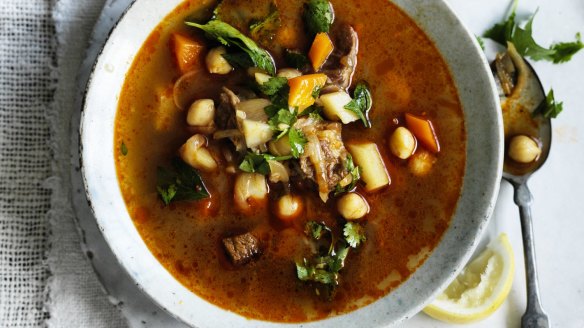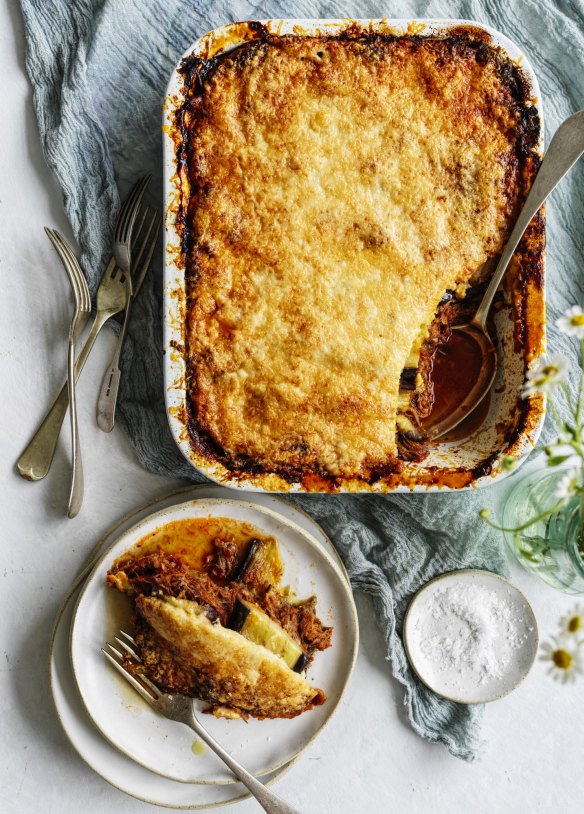What can you cook with leftover roast lamb?

We have an awful amount of roast lamb leftover after Easter. What can I do with it? L. Durrell
There is a heart-stopping favourite of graziers from yesteryear. A light batter of slightly leavened flour was used to coat slices of roast lamb, which were then shallow fried in dripping. Not approved by the Heart Foundation, in fact, I think it could warrant a skull and crossbones. It is delicious with tomato chutney. That was from the 1930s.
Today you could consider making a shepherd's pie by cooking chopped lamb with stock, vegetables, and onion, thickening the juices with a roux and placing in a pie dish. Top with mashed potato, brush with melted butter, and bake in a medium oven until golden.

I also like a Middle Eastern-inspired lamb soup. During roasting, the lamb gives up many of its juices to the pan, which concentrate during cooking, which is why you need to make gravy in the roasting pan. When cooking with precooked meat, you need to invigorate the dish with additional stock, such as good quality chicken stock.
For a hearty soup, simmer several cups of chopped lamb with a tin of chickpeas, half a teaspoon of cumin seeds, several cloves of crushed garlic, a small knob of ginger peeled and chopped, a cup of chopped pumpkin, and a few chopped carrots in a litre of stock for 40 minutes. Serve with chopped coriander leaves, yoghurt, a drizzle of olive oil, and some finely chopped preserved lemon.
- Also try: Neil Perry's spicy lamb and chickpea soup (pictured)
- How to turn roast lamb into ragu
- RecipeTin Eats' shredded lamb moussaka
What causes the blue in blue cheese? P. Montgomery
Mould. A penicillium mould originally came from the soil around the caves at Roquefort, a hill town in the south of France, some 60 kilometres north-west of Montpellier. Cheeses are inoculated with the mould Penicillium roqueforti, as well as other cultures. This mould has been used in making Roquefort cheese for hundreds, if not thousands of years.
Local legend has it that a young shepherd was eating his cheese in a cave, spied a love interest, left his lunch for a better offer only to return to find his cheese had turned green but was absolutely delicious.
The blue mould inside the cheese needs oxygen to grow, which is why blue cheeses can have an open texture. To assist the blue mould developing, cheesemakers insert a thick needle into the cheese, which allows air inside and helps the mould to grow.
I was reading a novel set in America's south and the characters often refer to collard greens. What are they? V. Hutton
Very good for you. They are a broadleaf variety of cabbage that looks a lot like silverbeet but with a lighter, waxier leaf. They are called collard not because of a collar but because they are a type of cabbage. You'll see that "col" prefix used in cabbage plants and dishes – think cauliflower, coleslaw, and the Scots variant kale.
Collard greens are closely associated with African-American culinary culture. They are cooked with beans and a little flesh, often pork, to make a stew, but more importantly, savoury liquor, which is used to restore health. Author Toni Morrison often had her characters preparing a dish like this in her work The Bluest Eye.
It is hard to find collard greens in Australia, but you can buy seeds to grow your own at edenseeds.com.au. If you need a substitute in a recipe, look for kale, chard, Chinese broccoli, or turnip tops.
Send your vexing culinary conundrums to brainfood@richardcornish.com.au or tweet to @foodcornish
-
- Also try: Neil Perry's spicy lamb and chickpea soup (pictured)
- How to turn lamb roast into ragu
Appears in these collections
More:
From our partners
Original URL: https://www.brisbanetimes.com.au/goodfood/what-can-you-cook-with-leftover-roast-lamb-20210330-h1uwsk.html
